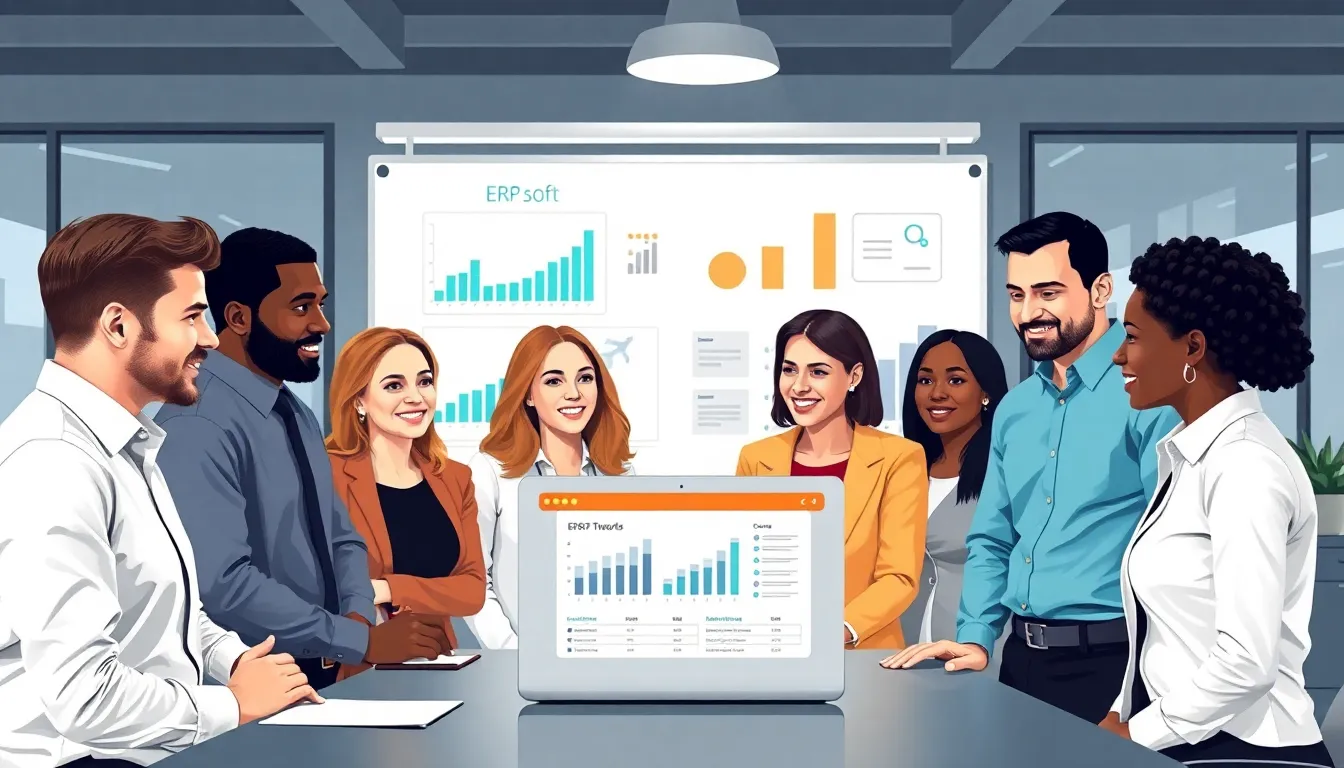Navigating the world of ERP software pricing can feel like trying to find a needle in a haystack—if that needle were also a unicorn and the haystack were made of spreadsheets. With so many options and price tags that range from “that’s a steal” to “do I really need to eat this month?” it’s crucial to understand what you’re getting into.
ERP Software Price
ERP software pricing varies greatly based on multiple factors. Understanding these elements helps businesses select the right system and budget accordingly.
Factors That Influence Pricing
Customization options play a significant role in pricing. The more tailored an ERP system is to specific business needs, the higher the cost may be. Implementation complexity also affects pricing. Simple setups incur lower fees, while extensive integrations raise costs. The deployment method, whether cloud-based or on-premises, influences expenses too. Generally, cloud solutions offer scalability with a subscription model, potentially lowering upfront investments. Additionally, user count impacts the overall price. More users translate into higher licensing fees. Companies must evaluate these factors carefully for informed decisions.
Common Pricing Models
Subscription-based pricing stands out as a popular model for ERP software. This approach involves monthly or annual fees, allowing for predictable budgeting. Perpetual licensing represents another option, where companies pay a one-time fee for indefinite access. This choice typically includes maintenance and support costs. Usage-based models charge based on actual software consumption, providing flexibility for varying needs. Furthermore, tiered pricing offers packages at different feature levels, letting businesses scale according to their requirements. Each pricing model has its own advantages and disadvantages, so organizations should assess them against their unique circumstances.
Breakdown of ERP Software Costs

Understanding ERP software costs involves several key components. Each element impacts the total financial commitment for businesses looking to implement such systems.
Licensing Fees
Licensing fees represent a significant portion of ERP costs. Subscription-based models typically charge monthly or annual fees per user, while perpetual licenses require a one-time upfront payment. Tiered pricing offers businesses flexibility, accommodating varying user counts at a discounted rate as they grow. Usage-based pricing calculates fees based on actual utilization, making it a cost-effective option for fluctuating demands. Carefully analyzing licensing structures assists organizations in selecting a model that aligns with their financial strategies.
Implementation Costs
Implementation costs can vary widely based on system complexity and organization size. Factors like data migration, custom configurations, and employee training contribute to these expenses. Engaging a consultant may enhance efficiency but also increases costs. Businesses often spend 50 to 100 percent of the software’s initial price on implementation. Establishing a clear scope with stakeholders can help manage these costs effectively, ensuring that projects remain on track and within budget.
Ongoing Maintenance and Support
Ongoing maintenance and support are essential for optimal ERP performance. Companies typically incur annual maintenance fees, averaging 15 to 20 percent of the total software price. These fees cover updates, system upgrades, and technical support. Support availability, including 24/7 assistance or limited hours, also influences costs. Investing in comprehensive support packages can minimize downtime and enhance user satisfaction, ultimately justifying the expense in the long term.
Comparing ERP Software Prices
Navigating ERP software prices requires careful analysis. Understanding specific costs associated with different solutions helps in selecting the right software.
Cost Comparison of Popular ERP Solutions
SAP Business One averages $94 per user monthly while Oracle NetSuite starts around $999 per month for basic packages. Microsoft Dynamics 365 offers tiered pricing, ranging from $70 to $210 per user monthly. Odoo provides a more budget-friendly option, beginning at $24 per user monthly. Comparing these prices enables businesses to evaluate options that fit their budgets.
Hidden Costs to Consider
Implementation costs often surprise organizations that overlook them. Complexity increases expenses significantly. Data migration, typically involving substantial labor hours, adds another layer of costs. Custom configurations often lead to unexpected spending as well. Employee training, essential for effective use, incurs additional charges. Lastly, ongoing maintenance and support fees, averaging 15 to 20 percent of the software’s total cost, demand consideration to ensure sustained performance.
Budgeting for ERP Software
Budgeting for ERP software involves understanding various cost elements. An informed budget allows organizations to choose solutions aligning with their needs.
Setting a Realistic Budget
Setting a realistic budget starts with understanding essential cost components. Companies must first analyze their needs and determine a range based on software type and user count. Licensing fees often contribute significantly, with options like subscription or perpetual pricing structures. Implementation costs can range from 50 to 100 percent of the initial software price, depending on complexity. Maintenance and support fees averaging 15 to 20 percent annually require attention as well. Assess existing infrastructure and estimate expenses for data migration and employee training. Prioritizing these aspects leads to a well-rounded budgeting approach.
Tips for Cost Savings
Cost savings in ERP budgeting can stem from several strategies. Opting for subscription-based models may reduce upfront costs, especially for smaller businesses. Simplifying implementation can lower associated fees, utilizing pre-configured solutions when available. Involving employees in training accelerates learning and reduces reliance on external trainers. Evaluating vendors for ongoing support options helps identify the best long-term value. Comparing multiple vendors before making a decision often uncovers better deals. Avoiding unnecessary customizations also keeps expenses manageable, allowing for future scalability without significant additional costs.
Conclusion
Navigating ERP software pricing requires careful consideration of various factors to ensure a sound investment. By understanding the components involved and the different pricing models available, businesses can better align their choices with specific needs and budgets. It’s essential to look beyond the initial costs and factor in implementation, maintenance, and potential hidden expenses. With a strategic approach to budgeting and a focus on long-term value, organizations can make informed decisions that support their growth and operational efficiency. Ultimately, the right ERP solution can streamline processes and enhance productivity, making it a worthwhile investment.